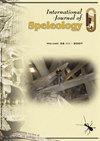气压在风洞和宝石洞中的传播:气压波如何在气压洞中传播?
IF 1.3
4区 地球科学
Q3 GEOSCIENCES, MULTIDISCIPLINARY
引用次数: 3
摘要
在气压洞穴中,外部大气和洞穴之间的气压梯度会产生强烈的双向补偿电流,这些电流控制着洞穴气候学的几乎所有要素,包括气温、湿度和二氧化碳动力学。因此,本研究着手调查美国南达科他州黑山两个主要的气压洞穴系统——风洞和宝石洞的气压传播。基于地面和洞穴内多个测点的高分辨率气压数据,确定并讨论了气压波在洞穴中传播过程中的四种系统变化及其相关的洞穴气候过程:与外界大气相比,风洞和宝石洞内的压力信号表现出:(1)由于测点高度不同而产生的绝对位移,(2)与压力波到达测点的时间有关的延迟,(3)平滑效应,(4)由于洞穴对外部压力变化的响应时间较长而产生的阻尼效应。研究结果表明,风洞洞口和狭窄的入口区域是压力传播的主要障碍,而宝石洞洞深区对气压梯度发展的影响最大。我们的分析对气压洞穴内部的过程和机制提供了全新的见解,这将对理解与压力相关的气流动力学和洞穴气候学的所有相关要素具有重要意义。本文章由计算机程序翻译,如有差异,请以英文原文为准。
Air pressure propagation through Wind Cave and Jewel Cave: How do pressure waves travel through barometric caves?
In barometric caves, air pressure gradients between the outside atmosphere and the cave induce strong bidirectional compensating currents, which control almost all elements of speleoclimatology, including air temperature, humidity, and CO2 dynamics. Therefore, this study set out to investigate air pressure propagation through Wind Cave and Jewel Cave – two major barometric cave systems in the Black Hills of South Dakota, USA. Based on high-resolution air pressure data from both the surface and several measurement sites inside the caves, four systematic changes of pressure waves during their journey through the caves and their related speleoclimatological processes were identified and discussed: Compared to the outside atmosphere, the pressure signals within Wind Cave and Jewel Cave showed (1) an absolute displacement due to different altitudes of the measuring sites, (2) a delay related to the travel times of the pressure wave to the measuring sites, (3) a smoothing effect, and (4) a damping effect due to long response times of the caves to external pressure changes. The spatial distribution of the changes observed in this study shows that for Wind Cave, the cave opening and the narrow entrance area represent the main obstacle for pressure propagation, while for Jewel Cave, the deep areas have the greatest influence on the development of air pressure gradients. Our analyses provide completely new insights into the processes and mechanisms inside barometric caves, which will significantly contribute to the understanding of pressure-related airflow dynamics and all related elements of speleoclimatology.
求助全文
通过发布文献求助,成功后即可免费获取论文全文。
去求助
来源期刊

International Journal of Speleology
地学-地球科学综合
CiteScore
3.10
自引率
23.10%
发文量
12
审稿时长
>12 weeks
期刊介绍:
The International Journal of Speleology has the aim to get cave and karst science known to an increasing number of scientists and scholars. The journal therefore offers the opportunity to all scientists working in and on karst to publish their original research articles or their review papers in an open access, high quality peer reviewed scientific journal at no cost. The journal offers the authors online first, open access, a free PDF of their article, and a wide range of abstracting and indexing services.
 求助内容:
求助内容: 应助结果提醒方式:
应助结果提醒方式:


